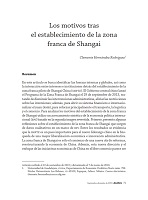The reasons behind the establishment of the Shanghai Free Trade Zone
DOI:
https://doi.org/10.32870/mycp.v5i15.515Keywords:
Shanghai Free Trade Zone (SHFTZ), international political economy, China, reform, financial liberalization, partnerships.Abstract
This paper seeks to identify domestic and global forces, as the interaction between interests and institutions behind the establishment of the China Shanghai Pilot Free Trade Zone (SHFTZ). Chinese central Government launched the Shanghai free trade zone Program on September 29, 2013 trying to diminish administrative interventions, ease restrictions on investments, further open up its financial system, and internationalize the Renminbi (yuan) to booster mainly shipping, logistics, and commerce. To analyze the reasons for the establishment of the free trade zone of Shanghai, I use a synthetic approach of the international political economy (IPE) based on the second image reversed. First, I present some thoughts about the establishment of the Shanghai free trade zone coming from qualitative data in an ipe framework. The results give evidence that the SHFTZ is an important step for China’s new leadership searching for greater economic liberalization and management innovation. The Shanghai free zone is just the beginning of a new wave of reforms, restructuring China’s economy. Furthermore, this new direction and focus of China’s economic initiatives regarding free trade seems to be a response to global pressures such as the regional free trade agreements that United States has recently negotiated.Downloads
References
Chen, G. (2013, 15 de julio). “Exclusive: Li Keqiang Fought Strong Opposition for Shanghai Free-Trade Zone Plan”, South China Morning Post. Recuperado de: http://www.scmp.com/news/china/article/1282793/li-fought-strong-opposition-Shanghai-free-trade-zone-plan, consultado 25 de abril de 2014.
China.org. (2014). Decision of the CCCPC on Some Major Issues Concerning Comprehensively Deepening the Reform. Recuperado de: http://www.china.org.cn/chinese/2014-01/17/content_31226494_7.htm, consultado 8 de marzo de 2014.
China-briefing. (2013a). Introduction to China’s Plenary Sessions and the CPC Central Committee. Recuperado de: http://www.china-briefing.com/news/2013/11/11/introduction-to-chinas-plenary-sessions-and-the-cpc- central-committee.html, consultado 14 de noviembre de 2013.
China-briefing. (2013b). Plans for the Future Development of the Shanghai Free Trade Zone. Recuperado de: http://www.china-briefing.com/news/2013/11/26/plans-for-the-future-development-of-the-Shanghái-free-trade-zone.html, consultado 29 de noviembre de 2013.
Definicion.de. (2014). Definición de zona franca. Qué es, significado y concepto. Recuperado de: http://definicion.de/zona-franca/, consultado 28 de abril de 2014.
Dumbaugh, K. (2010). Understanding China’s Political System. Diane Publishing.
Free-Trade Zone (International Trade). (2014). En Encyclopædia Britannica Online. Recuperado de: http://www.britannica.com/ebchecked/to-pic/218417/free-trade-zone, consultado 11 de enero de 2014.
Fung, E. S. K. (2010). The Intellectual Foundations of Chinese Modernity: Cultural and Political Thought in the Republican Era. Estados Unidos: Cambridge University Press, p. 25.
Gao, H. (2013). “Convertibility as a step for the rmb internationalization”, Economic Change & Restructuring, 46(1): 71-84. doi: 10.1007/s10644-012-9137-0
George, A. L., y Bennett, A. (2005). Case Studies and Theory Development in the Social Sciences. MIT Press.
Gilpin, R. (2001). Global Political Economy. Estados Unidos: Princeton University Press.
Global Times. (2013, 7 de noviembre). “Official urges ‘replicable’ FTZ Reforms”. Recuperado de: http://www.globaltimes.cn/content/823350.shtml#.uqwq40swqlc, consultado 17 de septiembre de 2014.
Gourevitch, P. (2009). “The Second Image Reversed: The International Sources of Domestic Politics”, International Organization, 32(4): 881-912. doi: 10.1017/S002081830003201X.
Hernández-Rodríguez, C. (2009). Política económica internacional. México: Astra Ediciones.
Hernández-Rodríguez, C. (2010). La influencia china: 98 ensayos sobre temas económicos, sociales, políticos y culturales de cómo China afecta a nuestro entorno. México: Astra Ediciones, p. 124.
Hu, S. (2013). “Han Zheng: How Shanghai’s Free Trade Zone Works [Han Zheng es el secretario del Comité Municipal de Shangai del Partido Co- munista de China]”, Caixin Online. Recuperado de: http://english.caixin.com/2013-11-14/100604877.html, consultado 30 de mayo de 2014.
Keohane, R. (1989). International Institutions and State Power. Boulder: Westview Press.
Krasner, S. D. (1994). “International Political Economy: Abiding Discord”, Review of International Political Economy 1(1): 13-19.
Martin, L. (2002). “International Political Economy: From Paradigmatic Debates to Productive Disagreements”, en M. Brecher y F. P. Harvey (eds.), Conflict, Security, Foreign Policy, and International Political Economy (pp. 244-251). Estados Unidos: The University of Michigan Press.
Pang, Z. (2011). “Rebalancing Relations between East Asian and Trans-Pacific Institutions: Evolving Regional Architectural Features”, en L. S. Ho y J. Wong (eds.), APEC and the Rise of China (pp. 45-64). Singapur: World Scientific Publishing.
PRPA. (2014). PRPA - Foreign Trade Zones. Recuperado de: http://www.phila-port.com/ftz.htm, consultado 14 de diciembre de 2014.
Ramírez, J. J. (2014). “El TPP vis-à-vis el RCEP: Ventajas y desventajas de ambos proyectos”, México y la Cuenca del Pacífico, 17(49): 17-53.
Ramírez, M., y Cortez, W. W. (2011). “¿Por qué China crece más rápido que México?”, en C. Hernández-Rodríguez (comp.), Cuenca Asia Pacífico: Temas de Economía, Negocios y Competitividad. México: Instituto Tecnológico de Monterrey.
Ravenhill, J. (Ed.). (2011). Global Political Economy, 3a edición. Estados Unidos: Oxford University Press.
Reuters. (2013, 30 de septiembre). “Shanghai FTZ Negative-List Published”. Recuperado de: http://cn.reuters.com/article/chinanews/idcncne98t00p20130930?pagenumber=3&virtualbrandchannel=0, consultado 16 de marzo de 2014.
Risse-Kappen, T. (Ed.). (1995). Bringing Transnational Relations Back In: Non- State Actors, Domestic Structures and International Institutions. Cambridge University Press.
Sassen, S. (1999). “Embedding the Global in the National”, en D. A. Smith, D. J. Solinger y S. C. Topic (eds.), States and Sovereignty in the Global Economy, (158-171). Reino Unido: Routledge.
Shanghai Daily. (2013). “China Launches Pilot Free Trade Zone in Shanghai”. Recuperado de: http://www.china.org.cn/business/2013-09/29/con- tent_30166167.htm, consultado 15 de octubre de 2013.
SHFTZ. (2013). Framework Plan for the China (Shanghai) Pilot Free Trade Zone, China (Shanghai). Pilot Free Trade Zone Official Website. Recuperado de: http://en.shftz.gov.cn/FrameworkPlan.html, consultado 14 de septiembre de 2014.
Symonds, P. (2014, 22 de abril). “Obama’s Tour to Reinforce ‘Pivot to Asia”, Global Research. Recuperado de: http://www.globalresearch.ca/obamas-tour-to-reinforce-pivot-to-asia/5378689, consultado 24 de Abril de 2014.
Ünay, S. (2013). “From Engagement to Contention: China in the Global Political Economy”, Perceptions: Journal of International Affairs 18(1): 129-153.
Underhill, G. (2006). “Conceptualizing the Changing Global Order”, en R. Stubbs y G. Underhill (eds.), Political Economy and the Changing Global Order (pp. 3-23). Oxford University Press.
Waltz, K. N. (2001). Man, the State, and War: A Theoretical Analysis. Estados Unidos: Columbia University Press.
Watson, M. (2005). Foundations of International Political Economy. Basingtoke: Palgrave MacMillan.
Wei, T. (2014). “Reform, Not Incentives, to Drive Expansion”, China Daily. Recuperado de: http://english.people.com.cn/90778/8342180.html, consultado 7 de julio de 2014.
Xinhua News. (2013, 29 de septiembre). “Shanghai FTZ Outlines Roadmap of New Reform”. Recuperado de: http://usa.chinadaily.com.cn/busi-ness/2013-09/29/content17003561.htm, consultado 29 de septiembre de 2014.
Xinhua News. (2014, 22 de enero). “China Approves 12 More Free Trade Zones”. Recuperado de http://news.xinhuanet.com/english/china/2014-01/22/c_133066293.htm, consultado 13 de abril de 2014.
Yan, M., Moore, S., Wang, R., y Guo, G. (2013). “China & The Third Plenum”, Brunswick Group. Recuperado de: http://www.brunswickgroup.com/media/229230/brunswick-china-analysis-cpc-third-plenary-session-november-2013.pdf, consultado 17 de noviembre de 2013.
Zhang Z. (2014). “Rinminbi Internationalization”, Peking University Law Journal, 2(2): 427-461.
Zhao, Q., y Wang, Y. (2015). “How Far is rmb from Global Currency: An Analysis Based on the Effect of Shanghai Pilot FTZ on RMB Internationalization”, SSRN. Recuperado de: http://ssrn.com/abstract=2558922, consultado 23 de enero de 2015.
Zweig, D., y Chen, Z. (Eds.). (2007). China’s Reforms and International Political Economy. Londres: Routledge.

Downloads
Published
How to Cite
Issue
Section
License
Open Access Policy
This journal provides open access to all its contents, in adherence to the principle that making research freely available supports a greater global exchange of knowledge.
MyCP is licensed under a Creative Commons Attribution-NonCommercial license, also known as CC BY-NC.
Contents are published in both PDF and XML formats.
Authors who publish in México y la Cuenca del Pacífico must accept the following conditions:
Pursuant to Mexican copyright laws, México y la Cuenca del Pacífico acknowledges and respects the authors’ moral right and ownership of property rights, which will be assigned to the University of Guadalajara to publish the articles in an open-access mode.
México y la Cuenca del Pacífico does not charge the authors any fees for receiving and processing their articles.
Authors are permitted to enter into other independent and additional contractual agreements for the non-exclusive distribution of the article version published in México y la Cuenca del Pacífico (for example, publishing it in an institutional repository or in other printed or electronic media) as long as they clearly state that the piece was originally published in México y la Cuenca del Pacífico.
Pursuant to the above, once the article is approved for publication, authors must send the Assignment of Rights Agreement form duly filled and signed. This form must be sent to mexicoylacuenca@gmail.com as a PDF file.
Readers/users of México y la Cuenca del Pacífico can freely access the journal new issues as soon as they are uploaded. Readers/users are allowed to cite, share (both electronically and physically), print and distribute the material, provided they expressly state that the work was originally published in México y la Cuenca del Pacífico. Contents are to be properly cited and never for commercial purposes.




